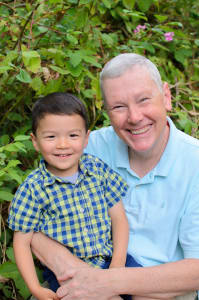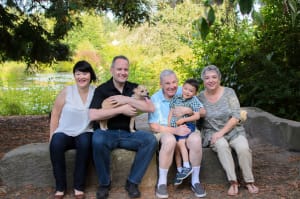In a matter of weeks, Mark Meerschaert went from being an athlete to someone who could barely walk; metastatic prostate cancer had come from nowhere and spread like wildfire throughout his body.
A highly respected mathematics professor and researcher – the kind who fills up the blackboard in his classroom with labyrinthine calculations to answer questions of probability, statistics, physics and the like – he did what he does best: looked at the numbers. Men with widespread prostate cancer that is not responding very well to standard-of-care treatment don’t live very long.

So then Mark did what we at the PCF believe all men should do: He became his own advocate, did some research, and found a different doctor, Heather Cheng, M.D., Ph.D., a medical oncologist at the Seattle Cancer Care Alliance, University of Washington School of Medicine and Fred Hutchinson Cancer Research Center. She also started the world’s first prostate cancer genetics clinic.
It turns out that Mark has a bad gene that runs in his family. It’s called BRCA2, and when it is mutated and not working as it should, it’s more notorious for increasing the risk of breast and ovarian cancer – but recently, scientists discovered that it increases the risk of prostate cancer, too.
Because of Mark’s bad copy of BRCA2, Cheng immediately focused on this gene and suggested a very different type of treatment – off-label use of a drug called olaparib, currently approved by the FDA to treat ovarian cancer. Olaparib is a PARP inhibitor; basically, it blocks a protein that cancer cells need to repair themselves, and has worked especially well in people with defects in the BRCA2 gene. Olaparib and other PARP inhibitors such as rucaparib and niraparib are currently being studied in clinical trials for prostate cancer patients.
“She said, ‘Let’s try something else,’” Mark recalls. Cheng told him that the medicine may take a few months to kick in fully. “I started olaparib in October of 2016. At the end of 2016, we did a bone scan, and saw that there was cancer all over the place: my ribs, hips, legs – I can’t remember all the places – some lymph nodes. One day, I walked my dog, and I had to sit down,” right in the middle of the walk, “and rest for 20 minutes.” That fall, Mark – on the faculty in the Department of Statistics and Probability at Michigan State University in East Lansing – organized a conference. He was the moderator, and was supposed to stand up for five minutes between talks and moderate discussions. “I couldn’t stand up for five minutes.”
He used a cane, then a walker, then a wheelchair. He took a leave of absence from his job. “I didn’t teach. I stand at the blackboard, walk around, write things on the board, move around, talk to the students. Math is like music; it’s a skill. You actually have to do it with your hands. You have to pick up a piece of chalk and write on the blackboard. I couldn’t do what I do.”
But now he is looking forward to returning to work. “The great thing is,” starting early in 2017, “I just slowly started to feel better and better,” he says. “At some point, I said, ‘Maybe I can go for a walk again. I had a little numbness in my foot, but I said, ‘I’m going to keep walking,’ so I did. I walk my dog every day, a couple of miles. Now even the numbness is gone.”
He has not had a follow-up bone scan yet. But “I know how it felt to have tumors in my spine and my hip. I couldn’t walk and I couldn’t stand, and now I can. I’m pretty sure when they do another scan what it’s going to show. In any case, I don’t care what it shows, because I feel good.

“When you’re 61 and in two or three months you go from an active life, running, walking, riding my bike, to not being able to stand up for five minutes and your wife is pushing you through the airport in a wheelchair – I am overly enthusiastic to feel normal, because normal seems so good. Just being able to go for a walk: I always enjoyed it, now I really cherish it. Because when you take it away, you really realize how much it means to you.
“In the last six months, I’ve gone from shockingly, disastrously ill to feeling – I’m still cautious, still waiting for the other shoe to drop; nobody knows how long this is going to work. There’s no data on people like me. Now I feel great.”
Bombshell: The Family History He Didn’t Know About
Mark is one of the pioneers of gene-targeted treatment for prostate cancer – medicine that, as Cheng explains, “is tailored to the weakness of his cancer resulting from a specific gene mistake in that cancer, rather than just treating it the same as all prostate cancers.”
“I knew that I was BRCA2 positive before I was diagnosed with prostate cancer,” he says; after his brother was diagnosed with breast cancer, several members of Mark’s family got genetic testing.
But he never expected to get prostate cancer. In fact, although Mark had gotten a PSA test every year, he had stopped. “My doctor said, ‘We don’t need to do PSAs.’ The concern was that there were unnecessary biopsies and even surgeries, and they’ve actually dissuaded people from screening.” So he stopped getting the PSA test. “For two years I didn’t get a PSA.”
Mark believes the policy of not screening men because of a fear of overtreatment is misguided. “A PSA costs almost nothing. To me it’s a misreading of the statistics,” somehow saying it’s worse for some men to get unnecessary biopsies than for other men to miss their shot at an early cancer diagnosis.
In 2013, Mark developed some urinary symptoms, and went to see a urologist. “It was Black Friday, the day after Thanksgiving. When everyone else was going to the mall, I went to the hospital and got a biopsy.” Cancer was found.
Around this time, he received some bombshell news: “My dad had prostate cancer. But I never knew that until after I was diagnosed. Had I known that, I would have kept PSA screening.” Mark’s father had other health problems, as well, and died of lung cancer. He was treated for prostate cancer when Mark was away in college, and his parents never said a word. “I’m a big fan of sharing knowledge with your family, even though it might be a little embarrassing. You might not feel comfortable talking to your kids about things like impotence, but they really need to know.”
Mark was put on a two-year course of androgen deprivation therapy (ADT) and given 42 daily treatments of external-beam radiation therapy. “ADT is not that bad,” he says. “Radiation is not that bad. I was feeling okay. I was living my life and going to work.” Well-meaning people told Mark the same things that many men with prostate cancer hear – that “prostate cancer is one of the good ones, the progression is really slow.” The two years of ADT ended in March 2016.
“By July of 2016, something just felt a little off. I went to see a urologist. He said, ‘There’s some scar tissue, I don’t think it’s anything to worry about, I saw something kind of weird, so I sent it off for a biopsy.’ It came back as high-grade cancer,” Gleason 9. The prostate cancer had come back with a vengeance. His PSA peaked at 36. It is now down to 7.
Genetic tumor sequencing:
When Mark went to the Seattle Cancer Care Alliance, “they got the tissue from last July and sequenced it.” This is an essential step in precision oncology – because prostate cancer can change over time. The genetic makeup of the cancer in Mark’s first prostate biopsy in 2013 was not the same as the tissue removed in 2016, after the cancer had time to mutate and become more dangerous. “They found out that I have the BRCA2 mutation in one of the two copies in my germline, but in the metastatic cancer cells, it was mutated in both copies.
“Dr. Cheng said, ‘Your cancer is very aggressive, but that might work in your favor going the other way.’ That turned out to be absolutely correct. It got bad really fast, and it got better really fast.” He is still taking the olaparib. “I guess I’ll keep taking it as long as it works. The question is, what happens next?
“I’m very interested in things like the five-year survival rate for people like me. Nobody knows. They’ve only been using this since 2015, and the studies were on ovarian cancer.”
So there are no guarantees. However, Mark says, “I can deal with that. I will be happy for what I get. I’m cautiously optimistic. The only thing prostate cancer has to do with my day-to-day life is, I take a bunch of pills, and I usually take a nap after lunch. If I’m back at work in the fall, I’ll probably take a nap after lunch.
“I do feel like this is something pretty remarkable. My God, what if this had happened five years ago?”










